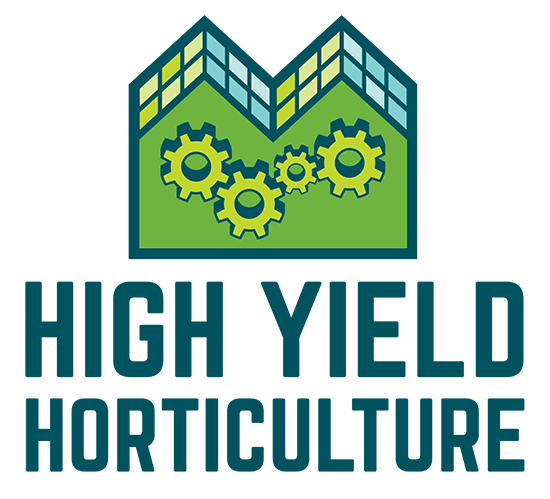The importance of maintaining targeted nutrient levels in a recirculating hydroponic system is critical. Understanding the way plants interact with a two-part stock solution can provide important insights into this process, and ultimately lead to bigger, faster growing plants.
To simplify, the Green Automation fertigation system consists of a line tank – where the solution is fed to the plants, a return tank – where the drain solution is collected post irrigation, a cloth filter to remove large particulates, and three peristaltic pumps – one for stock A, one for stock B, and one for pH control. The line tank is where dosing occurs and where fresh water is added to the system, and this is controlled based on sensors for pH, and electrical conductivity (EC). pH is the measurement of hydrogen ions in a solution (technically it’s the negative log of the hydrogen ion concentration) and EC is the measurement of all the ions in solution and does not measure the balance of individual elements. This critical balance of specific plant essential ionic elements must be regulated through the content (recipe) of the stock solutions.
If the system was not recirculating, which is called drain to waste, creating nutrient recipes becomes much simpler. However, this type of system is extremely wasteful of both water and fertilizers, which leads to much higher operational costs and negative impacts to the environment. Pre-formulated fertilizer stock solution blends are intended to be used with drain to waste systems. When these are used in a recirculating system, nutrients can get out of balance very quickly, which results in slow growth and stunted plants. In a drain to waste system the stock solutions are simply the formulation that is intended to be fed to the plants. In a recirculating system the stock solutions are used to top off the recycled solution and maintain the desired balance of nutrients, depending on what the plants are consuming. In a standard two-part stock solution, the two concentrated solutions stock A and stock B are intended to be added equally. There are two different stock tanks because certain elemental ions are not compatible together at high concentrations and will combine to form insoluble compounds and fall (precipitate) out of the solution.
For example, let us say the following breakdown and formulation of macro nutrients is in the line tank and applied to the plants:
nitrogen: 200 ppm (parts per million, or mg/L)
phosphorus: 20 ppm
potassium: 200 ppm
calcium: 200 ppm
magnesium: 65 ppm
sulfur: 100 ppm
Volume: 20,000 liters
EC: 2.0
pH: 6.0
Now, let us look at the breakdown of the same solution that is collected in the return tank after the plants have been irrigated:
nitrogen: 125 ppm
phosphorus: 10 ppm
potassium: 150 ppm
calcium: 200 ppm
magnesium: 80 ppm
sulfur: 200 ppm
Volume: 15,000 liters
EC: 2.5
pH: 6.5
The system only recognizes the change in total volume, the EC and the pH, and it will adjust these levels accordingly. In this example, the system will add 5000 liters of water to the line tank, inject stock A & B to bring the EC back to 2.0, and inject acid to lower the pH to 6.0. Below is a table detailing a summary of this process.
| Beginning solution | Ending solution | Difference | Adjusted solution after being topped off with fresh water, stock solutions, and sulfuric acid | |
| Nitrogen (ppm) | 200 | 125 | -75 | 155 |
| Phosphorus (ppm) | 20 | 10 | -10 | 13 |
| Potassium (ppm) | 200 | 150 | -50 | 180 |
| Calcium (ppm) | 200 | 200 | 0 | 230 |
| Magnesium (ppm) | 65 | 80 | 15 | 90 |
| Sulfur (ppm) | 100 | 200 | 100 | 218 |
| Volume (liters) | 20,000 | 15,000 | -5000 | 20,000 |
| EC | 2.0 | 2.2 | 0.2 | 2 |
| pH | 6.0 | 6.5 | 0.5 | 6 |
As you can see, the composition of the solution being fed to the plants in the line tank changes rapidly if the same standard stock solutions are used. There is a substantial difference looking at the adjusted solution versus the beginning solution. The uptake of nutrients will also vary based on changes to environmental conditions (light, temperature, humidity, CO2, etc). To compensate for this, weekly samples should be taken from the line tank and the return tank and sent to a lab for complete analysis. This gives the grower the information they need to understand what the plants are and are not consuming. Changes can then be made to the stock solution formulations to ensure the plants are getting exactly what they need. This is critical to maintain ideal growth within a recirculating system, especially with the yield capabilities of the Green Automation system. The GA baby leaf system is an incredibly advanced and ultra-high-performance cultivation system and should be treated as such. For example, A race car requires very different fuel compared to an economy car – an analogy that’s a good comparison to the nutrient requirements of the Green Automation system compared to a standard drain to waste system.

